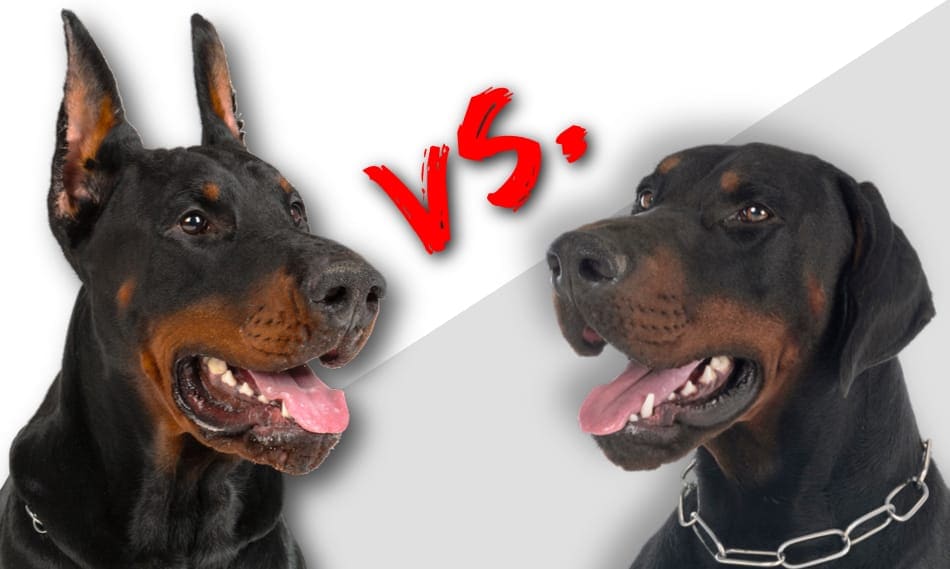Have you ever wondered how doberman ear cropping works? It is a surgical procedure that involves shaping and positioning a doberman’s ears to stand upright. This practice has been debated for its ethics and necessity, but it remains a common practice among some doberman owners. Understanding the process and its implications is crucial for anyone considering ear cropping for their doberman.
Ear cropping has a long history rooted in the breed’s origins. It was initially done to reduce the risk of ear infections and improve the doberman’s appearance. Today, the American Kennel Club recognizes both cropped and uncropped ears in dobermans, leaving the decision to the owner. However, there are still instances where ear cropping might be required for medical reasons, such as treating ear hematomas or correcting ear deformities. It is essential to consult with a veterinarian who specializes in this procedure and weigh the pros and cons before making a decision.
Ear cropping is a surgical procedure conducted by a veterinarian to alter the shape of a Doberman’s ears. The process involves removing a portion of the ear and then shaping and suturing it into an upright position. This procedure is typically performed when the puppy is around 7-12 weeks old. It is important to consult with a professional veterinarian to ensure the procedure is done safely and ethically.

How Does Doberman Ear Cropping Work?
Ears are an important physical feature of a Doberman Pinscher, and many owners choose to have their dog’s ears cropped for various reasons. Ear cropping is a surgical procedure that involves reshaping and removing a portion of the dog’s ear to give it an upright, tapered appearance. In this article, we will explore the process of how Doberman ear cropping works and discuss important aspects of the procedure.
Why is Ear Cropping Done?
Ear cropping is commonly done for cosmetic purposes in Doberman Pinschers. The upright, erect ears are considered a breed standard and give the dog a more alert and assertive appearance. Additionally, ear cropping can help prevent ear infections since cropped ears have better airflow. It is important to note that ear cropping is a personal choice and is not necessary for the dog’s health or well-being.
It is essential to consult and work with a professional veterinarian who has experience with ear cropping to ensure the well-being and safety of the dog.
The Ear Cropping Procedure
The Doberman ear cropping procedure is typically done when the puppy is between 7 and 12 weeks old. The procedure involves the following steps:
- Anesthesia: The puppy is placed under general anesthesia to ensure they do not experience any pain during the procedure.
- Marking: The veterinarian will carefully mark the areas where the ear will be cropped to achieve the desired shape and length.
- Cutting: Using surgical scissors or a scalpel, the veterinarian will make an incision along the marked lines to remove the excess ear tissue.
- Suturing: The remaining edges of the ear are sutured together, allowing the ear to heal in an upright position.
- Dressing: A bandage or ear stand is applied to the ear to provide support and aid in the healing process.
- Post-Op Care: The dog will require regular follow-up visits to ensure proper healing and to remove any stitches.
It is important to note that the ear cropping procedure can only be done by a licensed veterinarian and should never be attempted at home. It requires proper surgical techniques, knowledge, and expertise to ensure the safety and well-being of the dog.
Aftercare and Healing Process
After the ear cropping procedure, it is crucial to follow the veterinarian’s instructions for proper aftercare. This may include:
- Keep the surgical site clean and dry.
- Administer any prescribed medications, such as pain relievers or antibiotics.
- Prevent the dog from scratching or rubbing the ears.
- Monitor the ears for any signs of infection, such as swelling, redness, or discharge.
- Return to the veterinarian for scheduled follow-up visits to remove stitches and monitor healing.
| Remember, each dog’s healing process may vary, and it is essential to provide proper care and attention throughout the recovery phase. |
Considerations and Alternatives
Ear cropping is a personal choice and comes with both pros and cons. It is essential to consider the following aspects before deciding to have the procedure done:
- Legal Restrictions: Ear cropping may be illegal in some countries or states, so it is important to research and understand the local laws and regulations.
- Reputation and Standards: Ensure that the veterinarian performing the procedure has experience and a good reputation for ear cropping. Request to see before and after photos of previous cases.
- Alternative Options: If you prefer not to have your Doberman’s ears cropped, they can be left natural. “Natural ears” may require regular cleaning and proper care to prevent ear infections.
- Personal Preference: Ultimately, the decision to have your Doberman’s ears cropped should be based on your personal preference and your understanding of the potential risks and benefits.
The Future of Ear Cropping
It is important to note that attitudes towards ear cropping are changing, and the practice is becoming less common in some countries. Many kennel clubs and breed organizations are moving away from requiring ear cropping for breed standards.
As responsible pet owners, it is essential to stay informed about the evolving opinions and regulations regarding ear cropping. Always prioritize the health and well-being of your Doberman Pinscher above cosmetic considerations.
Conclusion
Ear cropping in Doberman Pinschers is a personal choice made by owners for cosmetic purposes. The procedure involves surgically reshaping the ears to achieve an upright and tapered appearance. It is important to consult with a licensed veterinarian who has experience in ear cropping to ensure the dog’s safety and well-being throughout the process. Proper aftercare and monitoring are crucial for a successful healing process. However, it is important to note that ear cropping is a personal decision and not a requirement for the dog’s health and happiness.
Key Takeaways: How Does Doberman Ear Cropping Work?
Doberman ear cropping is a surgical procedure where the ears of a Doberman Pinscher are reshaped to stand erect.
- Ear cropping is usually done when the puppy is around 7-9 weeks old.
- The procedure involves cutting and shaping the cartilage of the ears under general anesthesia.
- After surgery, the ears are bandaged and will require regular cleaning and care.
- Ear crops can be done for aesthetic purposes or to meet breed standards.
- It is important to choose a reputable and experienced veterinarian for the procedure.
Frequently Asked Questions
Doberman ear cropping is a procedure in which the ears of a Doberman Pinscher are surgically altered to make them stand upright. It is a controversial practice that has been done for cosmetic reasons in some countries. Here are some common questions and answers about how ear cropping works.
1. Why do people choose to crop their Doberman’s ears?
People choose to crop their Doberman’s ears for various reasons, including aesthetic purposes, breed standards, and historical tradition. The cropped ears can give the dog a more alert and intimidating appearance, which some owners prefer. Additionally, ear cropping is seen as a way to align the dog’s appearance with the breed standard set by kennel clubs and breed organizations. It is important to note that ear cropping is banned in some countries due to concerns of animal welfare.
In dealing with breed standards, cropped ears have long been associated with Doberman Pinschers since the practice began in the breed’s early history. Although some people argue that ear cropping is unnecessary and purely cosmetic, it remains a personal choice for many Doberman owners who believe in upholding the breed’s traditional appearance.
2. How is the ear cropping procedure done?
The ear cropping procedure is typically done when the puppy is between 8 and 12 weeks old. It is performed under general anesthesia by a veterinarian who has experience with the procedure. The ears are trimmed and shaped to achieve the desired upright appearance. The edges of the ears are sutured together, and the ears are then wrapped to protect the incisions and promote healing. The puppy will need to wear a protective headwrap or bandages for several weeks following the surgery.
It is crucial to choose a reputable and qualified veterinarian who follows proper surgical techniques and provides appropriate pain management and aftercare for the puppy. Discussing the procedure with a veterinarian and learning about the potential risks and complications is essential before making a decision to have the ears cropped.
3. Is the ear cropping procedure painful for the dog?
Ear cropping is considered a painful procedure for the dog. While the puppy is under anesthesia during the surgery, they will experience discomfort and pain during the recovery period. Pain medication is typically prescribed to help alleviate the post-operative pain. It is important for owners to closely follow the veterinarian’s instructions for pain management and provide a calm and comfortable environment for the puppy during the healing process.
However, it is worth noting that many veterinary associations and animal welfare organizations, including the American Veterinary Medical Association (AVMA), oppose the cosmetic ear cropping procedure, citing unnecessary pain and potential complications for the dog.
4. What are the potential risks and complications of ear cropping?
Ear cropping, like any surgical procedure, carries risks and potential complications. Some complications that can occur include infection, excessive bleeding, uneven ear appearance, poor wound healing, and long-term ear deformities. It is crucial to choose a qualified veterinarian who has experience with the procedure and follow their aftercare instructions to minimize these risks. Regular check-ups with the veterinarian are important to monitor the healing process and address any complications promptly.
It is also important to consider the potential long-term effects on the dog’s behavior and overall well-being. Some studies suggest that cropped ears may affect a dog’s ability to communicate through ear movements, as well as their sensitivity to sounds. These effects are not well understood and may vary on an individual basis.
5. Is ear cropping necessary for a Doberman Pinscher?
Ear cropping is not necessary for the health or well-being of a Doberman Pinscher. It is a purely cosmetic procedure that is a personal choice for the owner. Many Doberman owners choose not to crop their dog’s ears and love them just the way they are.
If you are considering ear cropping for your Doberman, it is important to thoroughly research and understand the procedure, potential risks, and local regulations before making a decision. Additionally, consulting with a veterinarian who can provide guidance and advice based on the individual dog’s health and well-being is crucial.

Doberman Pinscher Ear Cropping: What’s it Like?
Doberman ear cropping is a surgical procedure in which a dog’s ears are trimmed and shaped to stand upright. The surgery is usually performed when the Doberman is between 7 and 12 weeks old.
The process involves removing a portion of the external ear, then using sutures and a splint to hold the remaining ear upright as it heals. The surgery must be done by a licensed veterinarian and is typically performed under anesthesia. It is important to note that ear cropping is a controversial practice and is not necessary for the health or well-being of the dog.
